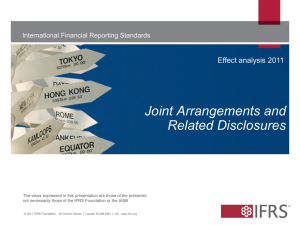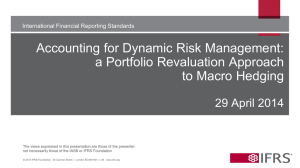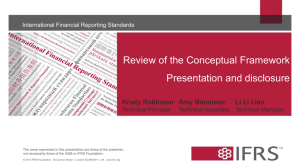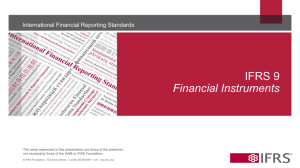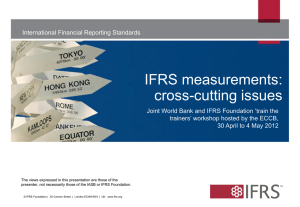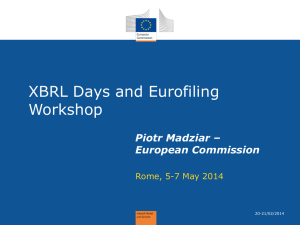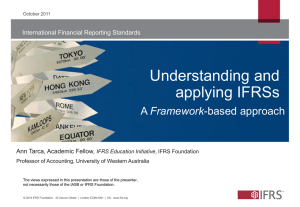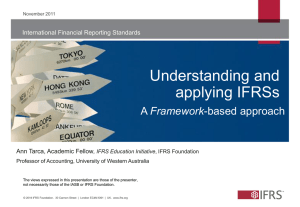IFRS 7 Financial Instruments: Disclosures
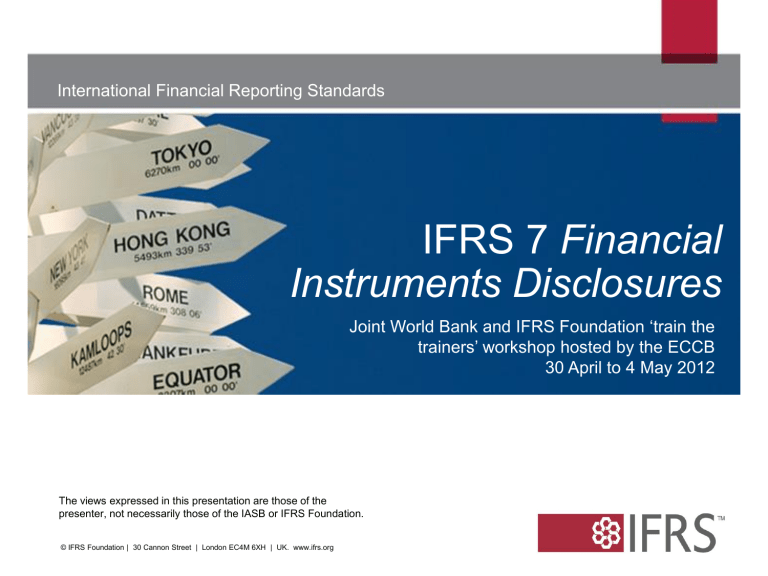
International Financial Reporting Standards
IFRS 7 Financial
Instruments Disclosures
Joint World Bank and IFRS Foundation ‘train the trainers’ workshop hosted by the ECCB
30 April to 4 May 2012
The views expressed in this presentation are those of the presenter, not necessarily those of the IASB or IFRS Foundation.
© IFRS Foundation | 30 Cannon Street | London EC4M 6XH | UK. www.ifrs.org
Introduction
• IFRS 7 sets out disclosures of financial instruments
• The presentation, recognition and measurement of financial instruments are the subjects of
• IAS 32 Financial Instruments: Presentation
• IAS 39 Financial Instruments: Recognition and
Measurement
• IFRS 9 Financial Instruments (being developed in phases) is intended to ultimately replace IAS 39.
2
© IFRS Foundation | 30 Cannon Street | London EC4M 6XH | UK. www.ifrs.org
Disclosure principles
3
Information that enables users to evaluate the significance of financial instruments for the entity’s financial position and financial performance.
• Information (qualitative and quantitative) that enables users to evaluate
• the nature and extent of risks arising from financial instruments to which the entity is exposed at the end of the reporting period.
• including information about how the entity manages its exposure to those financial risks.
© IFRS Foundation | 30 Cannon Street | London EC4M 6XH | UK. www.ifrs.org
Disclosure requirements
• Qualitative information about exposure to risks arising from financial instruments.
• The disclosures describe management’s objectives, policies and processes for managing those risks
4
© IFRS Foundation | 30 Cannon Street | London EC4M 6XH | UK. www.ifrs.org
Disclosure requirements
continued
5
• Quantitative information about exposure to risks arising from financial instruments, including specified minimum disclosures about
• credit risk,
• liquidity risk and
• market risk.
• These disclosures provide information about the extent to which the entity is exposed to risk, based on information provided internally to the entity’s key management personnel.
© IFRS Foundation | 30 Cannon Street | London EC4M 6XH | UK. www.ifrs.org
Comparison to the IFRS for SMEs
• The IFRS for SMEs requires less detailed disclosure of financial instruments.
6
© IFRS Foundation | 30 Cannon Street | London EC4M 6XH | UK. www.ifrs.org
Judgements and estimates
7
• Qualitative and quantitative information to evaluate the nature and extent of the entity’s exposure to and management of risks arising from financial instruments, including:
• amounts that best represent maximum exposure to credit risk.
• sensitivity analysis for each type of market risk showing how profit or loss and equity would have been affected by changes in relevant variables that are reasonably possible.
© IFRS Foundation | 30 Cannon Street | London EC4M 6XH | UK. www.ifrs.org
Judgements and estimates
continued
8
• Fair value information is required to be provided for all financial assets and liabilities (with limited exceptions) irrespective of whether they are carried at FV .
© IFRS Foundation | 30 Cannon Street | London EC4M 6XH | UK. www.ifrs.org
International Financial Reporting Standards
Offsetting
Financial Assets and
Financial Liabilities
The views expressed in this presentation are those of the presenter, not necessarily those of the IASB or IFRS Foundation
© IFRS Foundation | 30 Cannon Street | London EC4M 6XH | UK. www.ifrs.org
Disclosure requirements
10
• Respond to comments:
• preparers: Cost-benefit – scope, class vs. counterparty, existing disclosure requirements
• investors: Need for information about gross and net exposures
• Provide information about exposures in normal course and in times of stress
• Don’t reconcile IFRSs and US GAAP but allow entities to be compared on a like basis
© IFRS Foundation | 30 Cannon Street | London EC4M 6XH | UK. www.ifrs.org
Disclosure requirements
continued
• Proposed disclosure:
Gross amounts before offsetting
(A)
[same for all preparers]
Gross amounts set off
(B)
[depends on offsetting model]
Net amounts presented in balance sheet
(C)
Other amounts in scope but not set off in balance sheet
(D)
Net amounts
(E)
[depends on offsetting model]
[depends on offsetting model]
[same for all preparers]
11
© IFRS Foundation | 30 Cannon Street | London EC4M 6XH | UK. www.ifrs.org
Example:
Disclosure
12
Assume an entity has a recognised derivative asset with a fair value of 100 and a recognised derivative liability with a fair value of 80 that meet the criteria for offsetting. The entity has another derivative liability with a fair value of 10 and cash collateral of 20 that do not meet the criteria for offsetting.
The financial assets would be disclosed as follows: a.
b.
c.
d.
e.
Financial assets Gross carrying amounts (before offsetting)
Gross amounts offset
Category
Derivatives 100 (80)
Net amount presented in statement of financial position
(a-b)
Amounts available to be offset (but not set off in stmt of financial position)
(ie in bankruptcy or default)
Net exposure
(c-d)
20
Financial instruments
(10)
Cash collateral
10 -
© IFRS Foundation | 30 Cannon Street | London EC4M 6XH | UK. www.ifrs.org
Example:
Disclosure continued 13
Same example Assume an entity has a recognised derivative asset with a fair value of 100 and a recognised derivative liability with a fair value of 80 that meet the criteria for offsetting. The entity has another derivative liability with a fair value of 10 and cash collateral of 20 that do not meet the criteria for offsetting.
The financial liabilities would be disclosed as follows:
Financial liabilities
Category
Derivatives a.
b.
c.
d.
e.
Gross carrying amounts (before offsetting)
Gross amounts offset
90 (80)
Net amount presented in statement of financial position
(a-b)
10
Amounts available to be offset (but not set off in stmt of financial position)
(ie in bankruptcy or default)
Net exposure
(c-d)
Financial instruments
-
Cash collateral
10 -
© IFRS Foundation | 30 Cannon Street | London EC4M 6XH | UK. www.ifrs.org
Application guidance to IAS 32
14
• Comments received highlighted inconsistencies in the application of the offsetting requirements in IAS 32
• In December 2011, the IASB separately clarified the application of the offsetting criteria in IAS 32 :
– Legally enforceable right of set-off:
– The normal course of business ;
– The event of default ; and
– The event of insolvency or bankruptcy
– Some gross settlement systems are considered equivalent to net settlement if they eliminate or result in insignificant credit and liquidity risk and process receivables and payables in a single settlement process or cycle.
© IFRS Foundation | 30 Cannon Street | London EC4M 6XH | UK. www.ifrs.org
Questions or comments?
Expressions of individual views by members of the
IASB and its staff are encouraged. The views expressed in this presentation are those of the presenter.
Official positions of the IASB on accounting matters are determined only after extensive due process and deliberation.
The requirements are set out in International Financial
Reporting Standards (IFRSs) , as issued by the IASB at
1 January 2012 with an effective date after 1 January
2012 but not the IFRSs they will replace.
The IFRS Foundation, the authors, the presenters and the publishers do not accept responsibility for loss caused to any person who acts or refrains from acting in reliance on the material in this PowerPoint presentation, whether such loss is caused by negligence or otherwise.
© IFRS Foundation | 30 Cannon Street | London EC4M 6XH | UK. www.ifrs.org
